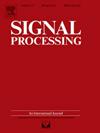点集匹配问题的最优运输导向多变量模型
IF 3.4
2区 工程技术
Q2 ENGINEERING, ELECTRICAL & ELECTRONIC
引用次数: 0
摘要
随着计算机视觉的快速发展,对复杂环境下点集匹配的需求越来越大,特别是在大变形和高噪声的情况下。然而,现有的算法往往精度低或计算成本高。为了在保证算法精度的同时提高算法效率,我们提出了一种新的点集匹配方法——多变量熵正则化最优传输模型(MeROT),该方法对点集的处理更加灵活。与传统的最优运输模型相比,该模型引入了正交变换矩阵和拉伸变换矩阵,能更好地处理点集的旋转和拉伸变换。此外,为了提高模型对噪声的鲁棒性和降低计算量,还引入了熵正则化项。随后,提出了一种交替迭代算法。由于两个矩阵的特殊性质和熵正则化项,算法中的每个子问题可以通过封闭解或采用有效的计算方法来解决。因此,MeROT具有很高的匹配精度和计算效率,非常适合当前复杂环境下的点云匹配问题。最后,通过对三维点集的实验验证了该模型的有效性。本文章由计算机程序翻译,如有差异,请以英文原文为准。
Optimal transport-guided multivariable model for point set matching problems
With the rapid development of computer vision, the demand for point set matching in complex environments is increasing, especially in cases with large-scale deformation and high noise. However, existing algorithms often exhibit low accuracy or high computational costs. To enhance algorithmic efficiency while maintaining precision, we propose a new point sets matching method named multivariable entropic-regularized optimal transport model (MeROT), which handles the point sets more flexibly. Compared with the traditional optimal transport model, the proposed model introduces an orthogonal transformation matrix and a stretching transformation matrix, which can better handle the rotation and stretch transformation of the point set. In addition, an entropic-regularization term is incorporated to enhance the model’s robustness against noise and to decrease the computational expense. Subsequently, an alternate iteration algorithm is proposed. Thanks to the special properties of the two matrices and the entropy regularization term, each subproblem within the algorithm can be resolved either through a closed-form solution or by employing an efficient computational method. Therefore, MeROT offers both high matching accuracy and computational efficiency, making it well-suited for point cloud matching problems in the current complex environment. Finally, several experiments on 3D point sets are designed to show the efficiency of the proposed model.
求助全文
通过发布文献求助,成功后即可免费获取论文全文。
去求助
来源期刊

Signal Processing
工程技术-工程:电子与电气
CiteScore
9.20
自引率
9.10%
发文量
309
审稿时长
41 days
期刊介绍:
Signal Processing incorporates all aspects of the theory and practice of signal processing. It features original research work, tutorial and review articles, and accounts of practical developments. It is intended for a rapid dissemination of knowledge and experience to engineers and scientists working in the research, development or practical application of signal processing.
Subject areas covered by the journal include: Signal Theory; Stochastic Processes; Detection and Estimation; Spectral Analysis; Filtering; Signal Processing Systems; Software Developments; Image Processing; Pattern Recognition; Optical Signal Processing; Digital Signal Processing; Multi-dimensional Signal Processing; Communication Signal Processing; Biomedical Signal Processing; Geophysical and Astrophysical Signal Processing; Earth Resources Signal Processing; Acoustic and Vibration Signal Processing; Data Processing; Remote Sensing; Signal Processing Technology; Radar Signal Processing; Sonar Signal Processing; Industrial Applications; New Applications.
 求助内容:
求助内容: 应助结果提醒方式:
应助结果提醒方式:


